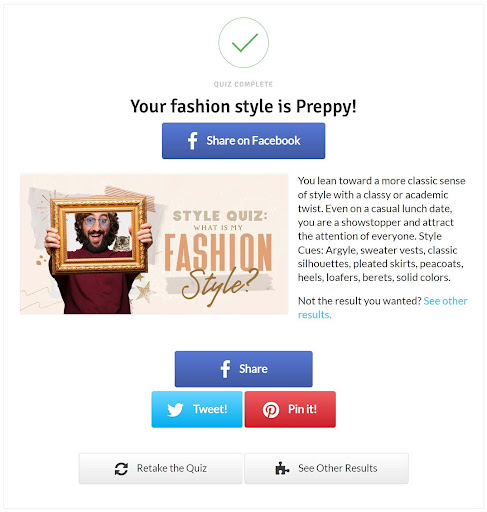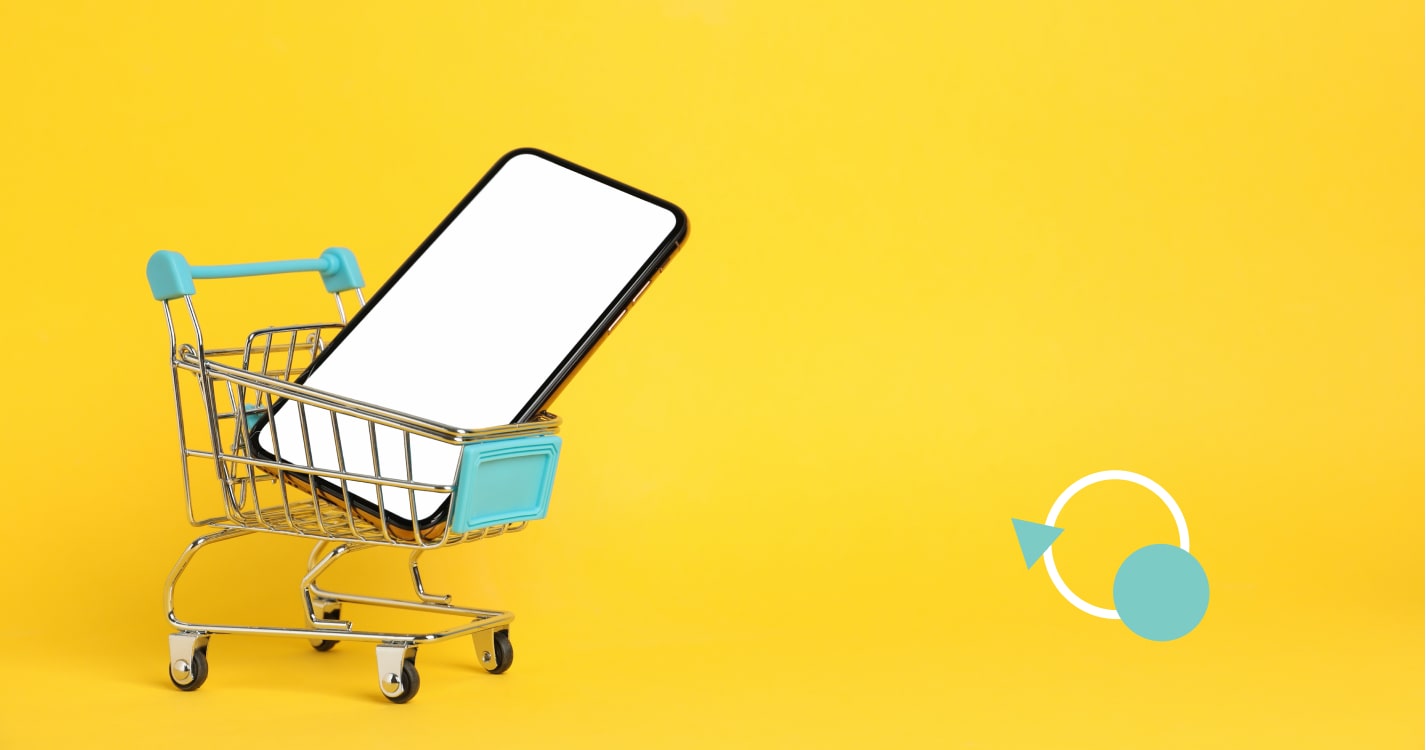As every online retailer knows, customer acquisition has always been one of the most important – and most difficult – parts of running a business. And unfortunately, things have only gotten more challenging in recent years.
Since Apple's iOS 14.5 update, which gave users the ability to opt out of data tracking, many eCommerce companies have found Facebook, once the most affordable source of traffic, significantly less effective. With online competition at an all-time high and data attribution muddied, marketers have been left scrambling for new ways to reach and engage potential customers.
But all hope is not lost! In a crowded eCommerce landscape, a marketer's best bet is to stand out with a creative lead generation strategy. Enter the style quiz.
What is a style quiz?
A style quiz is a questionnaire that is used to determine an individual's style preferences. It's a fun, interactive way to engage potential customers, capture leads, and personalize the shopping experience. Often implemented on a landing page or as part of a pop-up, style quizzes provide a win-win experience for both users and retailers.
Users enjoy a shopping experience tailored to their unique tastes, saving them the time and effort of browsing through a website's vast array of products. Meanwhile, retailers can collect contact information and better segment leads. Armed with more targeted content and product recommendations, eCommerce shops can increase conversion rates, drive sales, and turn one-time shoppers into lifelong brand advocates.
How to make a style quiz that drives sales
To make a style quiz that generates attention and converts leads into customers, there are a few key steps. Here are the six C's of effective style quizzes:
1 - Choose a type of style quiz
While each style quiz is unique, most can be classified into one of three categories:
Product recommendation
A product recommendation style quiz is a great way to increase engagement and boost conversion rates. By asking users about their preferences, you can recommend products that are more likely to appeal to them, resulting in a higher chance of purchase. For example, apparel brands may ask about cuts, patterns, and fit, while cosmetics companies may focus on makeup style and color preferences.
Consultation

Care/Of uses a consultation-like style quiz to match users with supplements.
Consultation style quizzes are less interested in the preferences of the user, and more focused on their needs. These quizzes ask potential customers about their challenges, pain points, and goals in order to provide them with tailored content and advice. By solving a user's problem, you increase the chances of positioning your brand as an authority, building trust, and making a sale.
Personality
Personality quizzes are some of the most popular style quizzes on social media. These fun, engaging quizzes ask users about their lifestyle choices, habits, and interests to determine their "type." Based on their answers, users are then given a label, such as "rocker" or "preppy," which can then be used to recommend a category of products that fit their style.
2 - Craft engaging questions
Once you've decided on a type of style quiz, it's time to start crafting the questions. As you jot down ideas, remember that style quizzes are distinct from customer feedback surveys and other types of marketing research. These quizzes will be used for prospecting.
In other words, users who are not yet familiar with your brand will be taking the quiz voluntarily. To build their interest and encourage participation, style quiz questions should be lighthearted, fun, and easy to complete! Take this as an opportunity to show off your brand's personality and connect with the user.
Also, make sure to include vivid imagery along with every question. These pictures should reinforce your branding when possible and help the user make more informed decisions. Product recommendation quizzes may highlight best sellers, whereas lifestyle quizzes may feature photos that come together to form a mood board.
Finally, stick with questions that are relevant to your brand and products. Not every question needs to be style-related, but they should all be useful in determining the user's style profile. By combining the insights from six to ten questions, your brand should feel comfortable categorizing the user and making product recommendations.
3 - Capture contact information
The goal of every style quiz is to generate leads that can be converted into paying customers. To do this, you'll need to capture the contact information of quiz-takers, such as their name, email address, and phone number.
In general, it's best to wait until the end of the quiz to ask for this information. If users are asked for their contact information too soon, they may feel uncomfortable and abandon the quiz altogether. By the time they reach the end, however, they should be invested in the process enough to want to see their results and learn more about the recommendations.
To further increase the chances of conversion, consider providing an incentive for users who complete the quiz. In addition to their results, offer a discount code, free entry into a giveaway, or an informative guide on how to resolve their problem. This small push may be all it takes to turn a casual quiz-taker into a lifelong customer!
4 - Create shareable results

Brainfall makes it easy for users to share their results on Facebook, Twitter, or Pinterest.
For a style quiz to take off organically, it needs to be shareable. After all, what's the point of taking a quiz if you can't show off your results? Users should be able to post their results on social media, email them to friends, or save them for future reference.
When designing the results page of your quiz, make sure to include an engaging title and description, along with an eye-catching image. This page should be compatible with every major social media platform and easy to share in as few clicks as possible. When friends and family visit the link, they should be able to review a summary of the results and be prompted to take the quiz themselves!
If implemented smoothly, this mechanism can result in free referral traffic and even virality. As users share their style quiz results with their social network, word-of-mouth can take over and expose your brand to entirely new audiences.
5 - Call-to-action

Nude Barre offers a discount code in exchange for users’ email addresses immediately prior to the results page.
The results page is also an opportunity to include a call-to-action (CTA). A CTA is a statement or button that encourages users to take a specific next step. In the context of style quizzes, this might be an offer to buy a recommended product, shop a relevant collection, or enroll in a subscription service.
Your brand's CTA should be directly tied to the quiz-taker's style profile and the products that suit them best. If a user is categorized as "boho", for example, you might include a carousel of items beneath the title "Our Best-Selling Bohemian Decor". And if your product recommendation quiz points users to a curated outfit, your CTA might read "Shop The Look".
By personalizing recommendations in this way, you can improve your conversion rate and encourage users to continue their customer journey. To further improve the efficacy of your CTA, consider highlighting statistics, reviews, or testimonials. These forms of social proof will build trust with your new leads and give them the confidence they need to make a purchase.
6 - Connect a follow-up squence
If your results page and CTA are compelling, a certain percentage of users will enjoy their recommendations and convert into paying customers. For those who don't, however, it's important to have a follow-up plan in place.
By connecting your style quiz to an email marketing platform, you can continue to nurture your leads and keep your brand top-of-mind. In your initial email, you might congratulate the user on their result and send along a coupon code for their first purchase. In subsequent emails, you can share new style guides, product recommendations, or even exclusive sales and discounts.
If after a few weeks you still haven't converted the quiz-taker, consider sending a "break-up" email. This final touchpoint gives you one last chance to save the relationship with a special offer.
Your style quiz email sequence can be set up in advance and requires very little maintenance after launch. Much like abandoned cart emails, style quiz follow-ups can be highly effective in educating leads and driving sales.
The style quiz software stack
So you're sold on style quizzes as a tool for eCommerce growth, but don't know how to get started? Here is the technology stack you'll need to build a style quiz for your online store:
eCommerce platform
To run a style quiz on your website, you'll need an eCommerce platform that supports custom development. If you're using Shopify, for example, you can install an app from the Shopify App Store or hire a developer to build a custom solution. For more of a self-serve solution, consider a website builder with drag-and-drop functionality like WordPress and WooCommerce. These platforms seamlessly integrate with our recommended quiz maker.
forms.app
forms.app is a powerful quiz maker that enables brand owners to whip up style quizzes, product recommenders, and personality tests in minutes. With no coding required, our app is perfect for those who want to build an engaging quiz without breaking the bank. Get started with one of our 27 pre-made quiz templates, which cover everything from skincare to mental health.
Email marketing software
Improve the return on investment of your style quiz with an automated email sequence. Companies like ConvertKit, Mailchimp, Drip, and Klaviyo allow you to segment style quiz leads and send targeted content based on their result. These follow-ups give brands the chance to further nurture leads through the marketing funnel and increase the likelihood of conversion.
Wrap up
Now that you know what it takes to drive eCommerce sales with a style quiz, it's time to start building! With this fun, interactive experience your brand can engage potential customers, capture leads, and personalize the shopping experience. If you are still not sure where to start, take a look at our style quiz templates for some inspiration.



